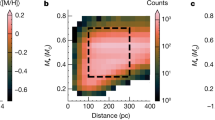Abstract.
There are great changes in our understanding of massive star evolution. Although it is a known fact that the populations of massive stars (O-stars, WR stars, blue and red supergiants) are very different in galaxies of different metallicities, the major role of axial rotation was not yet fully realised. Rotation dramatically influences all model outputs. Moreover, recent observations suggest raster rotation at lower metallicities, a result which may thus be particularly critical for the interpretation of the spectra and chemical abundances of high redshift galaxies.
Preview
Unable to display preview. Download preview PDF.
Similar content being viewed by others
Author information
Authors and Affiliations
Editor information
Rights and permissions
About this paper
Cite this paper
Maeder, A. Massive Stars and Their Role in Spectra and Abundances of High Redshift Galaxies. In: Bergeron, J., Renzini, A. (eds) From Extrasolar Planets to Cosmology: The VLT Opening Symposium. ESO ASTROPHYSICS SYMPOSIA. Springer, Berlin, Heidelberg. https://doi.org/10.1007/10720961_47
Download citation
DOI: https://doi.org/10.1007/10720961_47
Published:
Publisher Name: Springer, Berlin, Heidelberg
Print ISBN: 978-3-540-67163-3
Online ISBN: 978-3-540-46517-1
eBook Packages: Springer Book Archive




